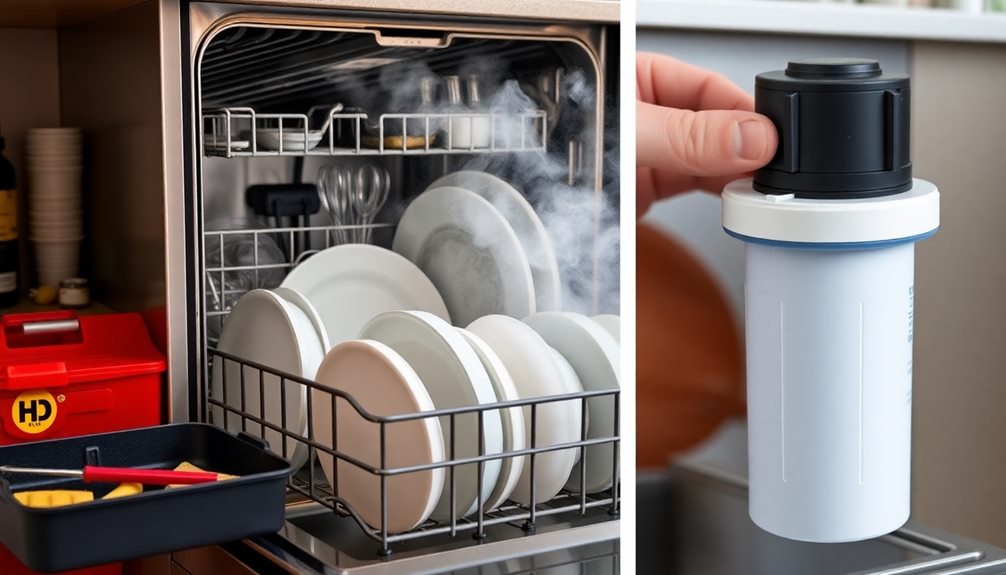If your dishwasher isn't drying properly, check a few key areas. First, ascertain you're loading dishes correctly, facing items downward for better drainage and avoiding overcrowding. Next, verify that you've got rinse aid in the dispenser; it helps water sheet off. Review your cycle settings, and make sure the heated dry option is activated. Inspect the vent for blockages and check if the heating element is functioning properly. Finally, open the door right after the cycle to let steam escape. With these tips, you can boost drying performance, but there's even more to learn for a fully efficient dishwasher.
Key Takeaways
- Ensure proper dish placement to enhance airflow and promote effective drying; avoid nesting items and position utensils for better drainage.
- Check and refill the rinse aid dispenser to prevent water spots and improve drying performance.
- Inspect the heating element for damage and test its functionality; a malfunctioning element can severely affect drying efficiency.
- Clear any blockages from the vent to ensure optimal airflow during the drying cycle; regular maintenance can prevent future issues.
- Consider using the heated dry option for better results, and open the door after the cycle to allow steam to escape.
Check Your Dishes
When dealing with a dishwasher that won't dry properly, the first thing you should do is check your dishes.
Start by examining your dish placement; proper arrangement is key to improving drying performance. Avoid stacking or nesting items, as this can lead to overcrowding, obstructing airflow and trapping moisture.
Be mindful of plastic items, which tend to retain excess moisture. When loading, position these items in a way that allows for better drainage. For instance, face cups and bowls downwards to prevent water accumulation.
Incorporating rinse aids can also enhance drying, but it won't fix poor loading techniques.
Make sure there's sufficient space between dishes to promote airflow, which is essential for effective drying. If you notice that certain materials, like glass and ceramic, dry faster than plastic, adjust your loading routine accordingly.
Review Dishwasher Cycles
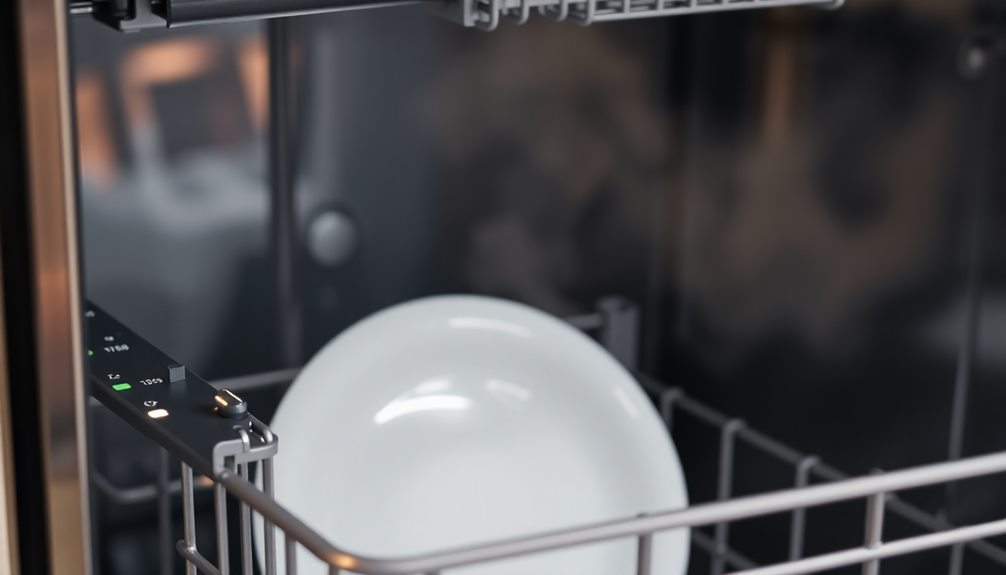
To enhance your dishwasher's drying performance, it's vital to review the available cycles and settings. Most dishwashers come with multiple dishwasher cycles, each tailored for different cleaning and drying needs.
Selecting the appropriate drying settings, like the heated dry option, can make a significant difference in how well your dishes dry. If you own a newer dishwasher model, check if the heated dry cycle is activated by default. If it's not, manually turning it on is important for best drying results.
Additionally, using a rinse aid can improve drying effectiveness and help prevent unsightly water spots. Confirm that the rinse aid chamber cap is functioning correctly for proper dispensing.
Another helpful tip is to open the dishwasher door after the rinse cycle. This allows steam escape, which promotes drying and helps evaporate any residual moisture left on your dishes.
For the best drying methods, consult your user manual for specific cycle options and settings that are tailored to your dishwasher model. By taking these steps, you'll enhance your dishwasher's overall drying performance, guaranteeing your dishes come out perfectly dry every time.
Inspect the Vent

Inspecting the vent is essential for guaranteeing your dishwasher dries dishes effectively. A well-functioning vent allows hot air to escape, preventing moisture buildup that can hinder the drying process.
Start by checking the vent for any blockages or debris that could obstruct airflow during the drying cycle. If you notice any obstructions, clear them out to facilitate ideal performance.
Some dishwasher models come with vents that include fan motors, so it's important to refer to your user manual for specific instructions on how to test these components. If you find malfunctioning components or a vent door that's stuck, it may require repair or replacement. Depending on the age and condition of your appliance, this could even be covered under warranty.
Regular maintenance, including cleaning the vent area, is essential to avoid future drying issues. By taking these steps to inspect the vent, you'll help guarantee that your dishwasher operates at its best and your dishes come out dry every time.
Don't overlook this crucial part of the drying process; it could make all the difference in how well your dishwasher performs.
Examine the Heating Element

After confirming the vent is clear, the next step involves examining the heating element. This component is significant for your dishwasher's drying performance, as it heats air to temperatures between 110-170°F. A well-functioning heating element is necessary for peak performance, similar to how regular filter replacement is important for air purifiers.
A visual inspection can help identify any damage, like burned-out areas, suggesting it may need to be replaced.
Here's what to look for during your inspection:
- Physical Damage: Check for any visible burns or breaks.
- Connections: Verify all electrical connections are secure and intact.
- Location: The heating element is typically behind the lower access panel, so consult your user manual for guidance.
To test the heating element's functionality, use a multimeter. You're looking for continuity; a proper reading should show resistance between 15-30 ohms. If you get a reading of zero or infinite, it indicates failure.
In that case, it's best to seek professional assistance for repairs or replacement. Addressing the heating element is crucial to prevent moist air from lingering, making sure your dishes come out dry and ready to use.
Top Drying Tips

Maximizing your dishwasher's drying efficiency can make a significant difference in how your dishes come out. If your dishwasher's not drying properly, start by using the heated dry option, which enhances drying performance.
Keep in mind that while it may increase energy usage, the results are often worth it.
Next, incorporate rinse aid into your routine; it helps prevent water spots and improves drying results.
After the drying cycle, don't forget to open the door immediately. This allows steam to escape, aiding evaporation and reducing excess water on your freshly cleaned dishes.
Proper dish placement is essential, too. Arrange your clean dishes with enough space between them to promote airflow; overcrowding can hinder drying efficiency.
Regularly check and clean the drying fan and vent, ensuring unobstructed airflow for effective drying.
Lastly, if your dishwasher still struggles with drying, examine the heating element to confirm it's functioning correctly.
Understand Drying Technologies
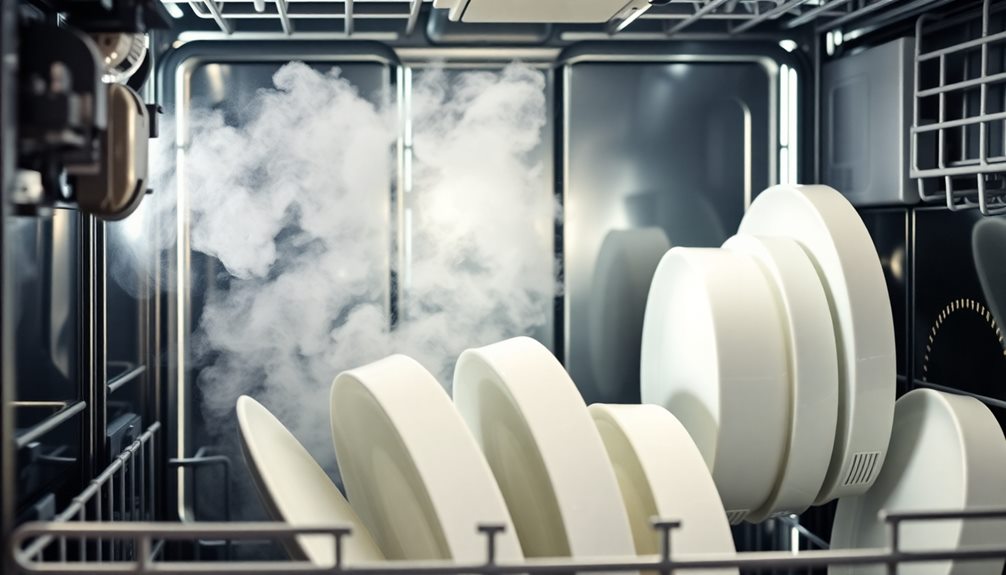
Understanding the drying technologies in your dishwasher is essential for achieving ideal results. There are two primary drying methods: heating element drying and condensation drying. Knowing the differences can help you choose the right settings for superior drying performance.
- Heating Element Drying: This method heats air to 110-170°F, effectively drying dishes. It's common in older models and generally offers enhanced drying performance.
- Condensation Drying: Utilizes residual heat and evaporation, making it more energy-efficient. However, it may not be as effective, especially for plastic items prone to moisture retention.
- Dishwasher Settings: Using the heated dry option when available can enhance drying effectiveness, especially for tougher loads.
If you're using an energy-efficient model, you might notice that it operates more quietly, often at the expense of drying performance.
To maximize your drying cycles, consider the materials of your dishes; glass and ceramic typically dry faster than plastic.
Identify Common Issues
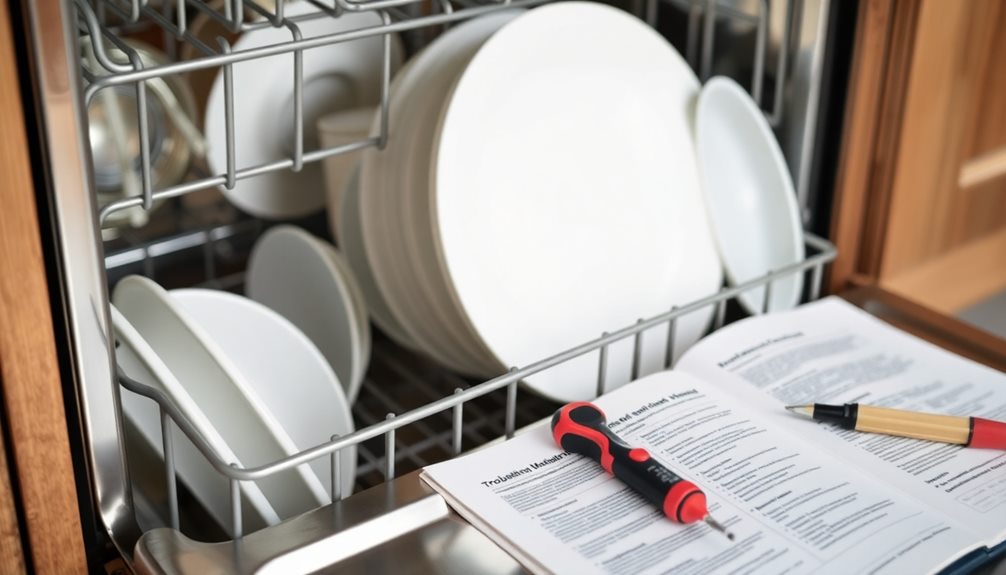
When your dishwasher isn't drying dishes properly, several common issues might be at play. One major culprit could be a malfunctioning heating element. This component is essential because it heats the air needed for effective drying. If it's not working, your dishes will remain wet.
Another common issue is inadequate rinse aid usage. If you're not regularly checking and refilling the rinse aid dispenser, you might notice water spots and poor drying performance.
Additionally, blocked vents can greatly hinder steam release, leading to moisture retention on your dishes. Make sure to inspect and clean these vents to improve air flow.
Environmental factors, like high humidity in your kitchen, can also impact drying efficiency. If the surrounding air is moist, your dishwasher's drying capabilities may struggle.
To troubleshoot these common issues, start by checking the heating element, rinse aid levels, and ensuring vents are clear. Addressing these factors can markedly improve your dishwasher's drying performance, leaving you with spotless, dry dishes every time.
Optimize Loading Techniques
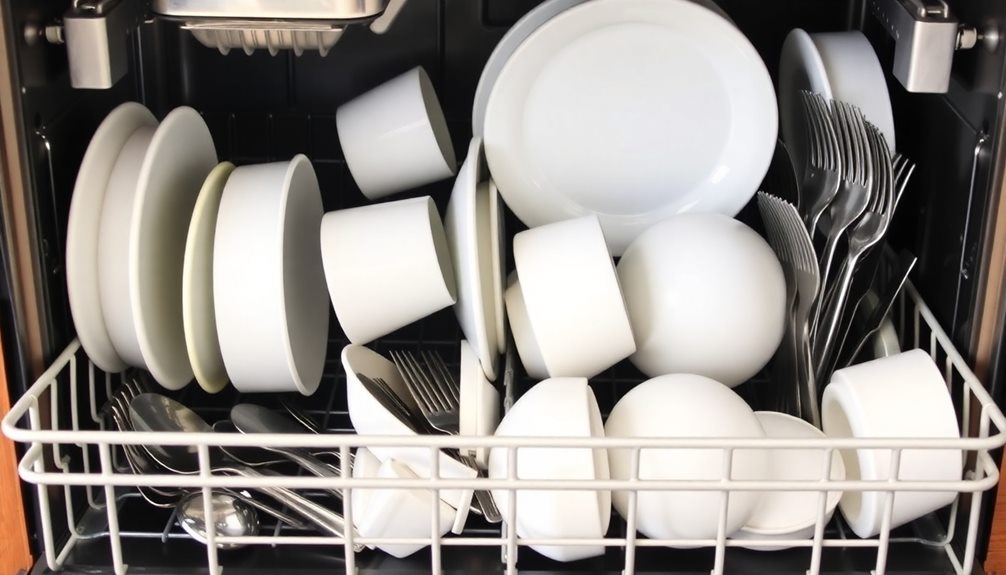
To improve your dishwasher's drying performance, focus on proper dish placement and spacing for airflow.
Make certain not to stack or nest items, especially lightweight plastics, and position cups and bowls facing downwards.
Also, spread out utensils in the cutlery rack to guarantee water flows freely, enhancing overall drying results.
Proper Dish Placement
How can you guarantee your dishes come out dry and spotless every time? Proper dish placement is key to maximizing your dishwasher's drying performance. By arranging your dishes wisely, you can help air escape and reduce moisture accumulation, especially during the rinse cycle.
Not only does effective loading enhance drying, but it also guarantees ideal cleaning results, similar to how the right best vacuums for dust removal can greatly improve your home's cleanliness.
Here are three essential tips for loading your dishes effectively:
- Space it Out: Confirm there's sufficient space between items to promote airflow. This helps prevent water from being trapped.
- Avoid Nesting: Don't stack or nest dishes. Place cups and bowls upside down to facilitate drainage and enhance drying.
- Top vs. Bottom Rack: Load lightweight plastic items on the top rack to avoid flipping and retaining water. Use the bottom rack for heavier items.
Additionally, follow the loading guides specific to your dishwasher model. This will help confirm you're using the right dishwasher cycle settings for effective cleaning and drying results.
Space for Airflow
Proper dish placement sets the foundation for effective drying, but optimizing space for airflow takes it a step further. To enhance your dishwasher's drying performance, ascertain there's sufficient space between dishes. This promotes airflow and prevents moisture buildup, which can lead to damp dishes.
Additionally, integrating smart home devices like smart thermostats can help monitor your appliance's energy usage and efficiency. Avoid stacking or nesting items, as this traps water and hinders effective drying. Instead, load items individually, allowing for maximum exposure to hot air.
When it comes to utensils, arrange them in the cutlery rack with enough separation to facilitate air circulation. This not only aids in drying but also prevents water retention.
For lightweight plastic items, place them on the top rack to avoid flipping; flipped items can collect water and remain damp after the rinse cycle.
On the lower rack, position plates and pots facing the center. This optimizes drainage and ascertains that water doesn't pool in concave areas.
Utensil Loading Tips
Maximizing drying efficiency hinges on the way you load utensils into the dishwasher. Proper loading techniques can greatly impact how well your utensils dry after a wash cycle. Here are some tips to optimize your utensil loading:
- Spread utensils evenly in the utensil holder to prevent nesting, which traps moisture and hinders drying efficiency.
- Place larger utensils, like serving spoons and spatulas, in the lower rack for adequate water exposure and drainage.
- Avoid overloading the utensil basket; leaving space promotes better airflow, which is essential for effective drying.
For forks and knives, position them with the handles facing down. This helps prevent water pooling, ensuring they're thoroughly cleaned and dried.
If you have a designated utensil basket or rack with slots, use it to keep items separated and enhance airflow around each piece.
Troubleshooting and Solutions
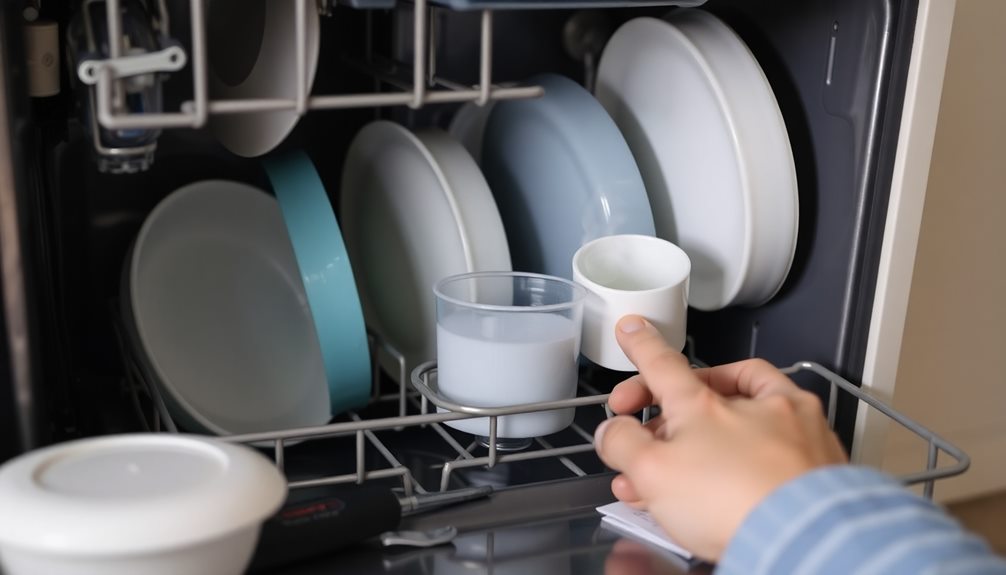
To get to the bottom of why your dishwasher isn't drying, start by checking the heating element for any damage or continuity issues.
Next, make certain your rinse aid dispenser is filled and functioning properly, as this can greatly improve drying performance.
Inspect Heating Element Functionality
A malfunctioning heating element can greatly impact your dishwasher's drying capabilities. To guarantee your dishwasher operates properly, you need to inspect the heating element.
First, locate it behind the lower access panel and visually inspect the heating element for any signs of damage, like burned-out areas. If you notice any, it might be time for a replacement.
Next, you'll want to test the heating element for continuity using a multimeter. The expected resistance readings should range between 15-30 ohms. If you find readings of zero or infinite, the heating element needs replacement.
It's also important to check for a malfunctioning high-limit thermostat, which can prevent the heating element from functioning correctly. Test it for infinite resistance at room temperature.
If you've gone through these steps and the drying issues persist, don't hesitate to seek professional assistance. Addressing these components can notably improve your dishwasher's drying efficiency, guaranteeing your dishes come out completely dry after each cycle.
Check Rinse Aid Levels
Check the rinse aid levels in your dishwasher regularly to guarantee peak drying performance. Rinse aid plays an essential role in reducing the surface tension of water, allowing it to sheet off your dishes instead of forming droplets. This process enhances drying performance and helps prevent pesky water spots.
Make it a habit to check rinse aid levels in the dispenser and refill it whenever the indicator light activates. Keeping the rinse aid dispenser clean is equally important, as buildup can hinder dispensing performance. If you notice water spots or wet dishes after a cycle, adjusting the rinse aid dispensing settings can ascertain the right amount is used for maximum drying.
Even if you're using 2-in-1 tablet detergents, don't skip on rinse aid. These tablets offer some cleaning benefits, but adding rinse aid provides additional drying benefits that are vital for achieving spotless results.
Assess Venting and Airflow
Venting and airflow are fundamental for guaranteeing your dishwasher dries your dishes effectively. If you're facing drying issues, it's essential to assess these components. Here's what you need to do:
- Inspect the vent: Look for any obstructions that could block hot air from escaping. A clogged vent can severely hinder the drying cycle.
- Check the vent door: Confirm it opens fully during the drying phase. If the vent door is stuck, it may need repair or replacement to function correctly.
- Verify the fan operation: Some dishwashers come with a fan to assist in venting. Make sure the fan is operational for ideal airflow.
Regular maintenance is key. Cleaning the vent area and removing any debris can greatly improve your dishwasher's drying performance.
Consult your dishwasher's manual for specific instructions on inspecting and troubleshooting the vent system. By confirming proper airflow, you'll enhance the effectiveness of the drying cycle and keep your dishes sparkling clean.
Don't overlook these aspects, as they play an important role in achieving the best drying results!
Frequently Asked Questions
How to Fix a Dishwasher That Won't Dry?
To fix your dishwasher that won't dry, guarantee proper loading, refill the rinse aid, check the heating element, verify the vent's functionality, and select the right wash cycle for ideal drying results.
Why Is My Dishwasher Wet Inside After Dry Cycle?
It seems your dishwasher's not quite finished its job. The lingering moisture could result from blocked vents, improper loading, or even a shy heating element. Check those factors, and you might just solve the mystery!
Why Is My Dishwasher Holding Moisture?
Your dishwasher might be holding moisture due to improper dish placement, high humidity levels, a malfunctioning vent, insufficient rinse aid, or issues with the heating element. Check these factors to improve drying performance.
How to Check if a Dishwasher Heating Element Is Working?
To check your dishwasher's heating element, first inspect it for damage. Then, use a multimeter to measure resistance. If the reading's zero or infinite, it's likely faulty and needs replacing. Check your manual for details.
Conclusion
If your dishwasher won't dry, don't throw in the towel just yet! By checking your dishes, reviewing cycles, and inspecting the vent, you can tackle the problem head-on. Remember to examine the heating element and optimize loading techniques for better results. With a bit of troubleshooting, you'll have your dishwasher running like a charm again. So roll up your sleeves and get to work—you'll soon be enjoying sparkling clean, dry dishes without a hitch!
